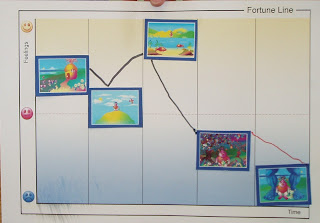 In the mid-1990's I was part of the Thinking Through Humanities project - a group of teachers from Northumberland working alongside David Leat and colleagues at the University of Newcastle. Among the strategies that we explored and developed were Fortune Lines, so I was particularly pleased to come across this strategy being used with 5/6 year olds recently.
In the mid-1990's I was part of the Thinking Through Humanities project - a group of teachers from Northumberland working alongside David Leat and colleagues at the University of Newcastle. Among the strategies that we explored and developed were Fortune Lines, so I was particularly pleased to come across this strategy being used with 5/6 year olds recently.Fortune Lines aim to map the feelings of one or more of the main characters in a story along a timeline. So whilst reading the Gruffalo, for example, the teacher encourages her children to think about how the mouse is feeling at the beginning of the story when he is minding his own business, then how he might feel as he is threatened by the fox, the owl, the snake (and how he feels when each one of them heeds his warning about the Gruffalo and retreats) and then, at the end when the Gruffalo turns up and scares the living daylights out of the whole forest!
An important aspect of the approach, as with all the so-called Thinking Skills strategies, is to challenge children's first answers thus calusing them to think more. For example, "Would the mouse have been sad the moment he med the fox or only once the fox had threatened to eat him?" or "Are you always sad when you're scared?"
Of course, this approach doesn't apply to young children. Various books in the Thinking Through series give superb examples of using Fortune Lines with 13/14 year olds studying events leading up to an historical event, or mapping the changing fortunes of a community as it moves from a primary industry such as coal mining through factory-based work to tertiary industries such as call centres. For more information, take a look at Thinking Through ... Geography, History, Maths or other subjects.

No comments:
Post a Comment